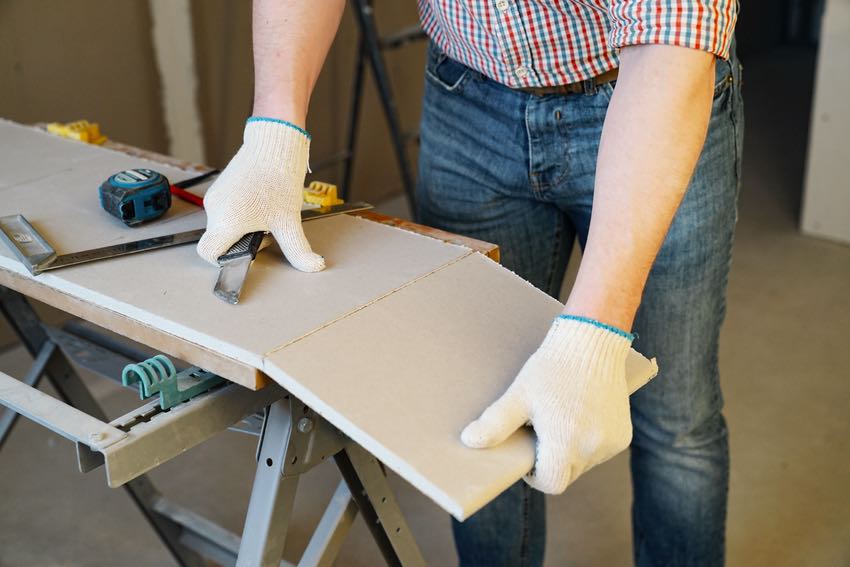Can you use a table saw to cut drywall? If you’ve ever wondered about this, you’re in the right place! Cutting drywall is a common task in home improvement projects, and having the right tools can make the job a breeze. In this article, we’ll explore whether a table saw is suitable for cutting drywall and provide you with all the information you need to know.
Drywall is a versatile material that is commonly used for constructing walls and ceilings. It’s made of gypsum and covered with a paper-like material, making it lightweight and easy to work with. When it comes to cutting drywall, there are various tools you can use, such as utility knives and rotary saws. But what about a table saw? Let’s find out if it’s a good option for this task.
Using a table saw for cutting drywall has its pros and cons. On one hand, a table saw can provide straight and accurate cuts, thanks to its fence and flat table surface. This can be especially helpful for larger projects or when you need to make multiple precise cuts. However, it’s important to note that drywall can create a lot of fine dust when cut, and table saws are not typically designed to handle this type of debris. So, while it is possible to use a table saw for cutting drywall, it’s essential to take safety precautions and use proper equipment to minimize the dust and protect yourself.

Can You Use a Table Saw to Cut Drywall?
When it comes to DIY projects and home renovations, cutting drywall is often a necessary task. While there are several tools available for this job, many people wonder if they can use a table saw to cut drywall. In this article, we will explore whether a table saw is a suitable option for cutting drywall, the benefits and drawbacks of using a table saw for this purpose, and tips for a successful cutting experience.
The Pros and Cons of Using a Table Saw for Cutting Drywall
While a table saw can be a versatile tool for woodworking and carpentry tasks, it may not be the most ideal choice for cutting drywall. Let’s take a closer look at the pros and cons of using a table saw for cutting drywall.
Benefits of Using a Table Saw
Using a table saw for cutting drywall offers some benefits that make it appealing to those who already have the tool on hand. Firstly, table saws are known for their precision and accuracy, which can result in cleaner cuts and smoother edges. Additionally, table saws often have larger cutting capacities, allowing for quicker and more efficient cutting of larger pieces of drywall. The presence of a fence on a table saw can also help in achieving straight and consistent cuts.
Furthermore, table saws allow for the use of specialized blades designed for cutting various materials, including drywall. These blades are often equipped with features such as carbide tips or anti-kickback mechanisms, which can enhance safety and cutting performance. Overall, if you already own a table saw and have the necessary accessories and blades, using it for cutting drywall can be a convenient option.
Drawbacks of Using a Table Saw
Despite the potential benefits, there are several drawbacks to consider when using a table saw for cutting drywall. Firstly, drywall is a dusty material, and the use of a table saw can generate a significant amount of dust. This dust can accumulate in the saw’s motor, gears, and other components, potentially causing damage or reducing the saw’s lifespan.
Moreover, drywall is a brittle material that can easily crack or break if not handled properly. The high speed and power of a table saw, combined with the lack of flexibility in the material, can lead to splintering, chipping, or even the complete destruction of the drywall. This can result in wasted material and the need for re-cutting, causing delays in your project.
Additionally, drywall is porous and can absorb moisture, which can cause it to warp or deform. Table saws generate heat during the cutting process, and the combination of heat and prolonged contact with the material can lead to moisture absorption and potential damage to the drywall. This is especially important to consider if you are cutting drywall for areas that require moisture resistance, such as bathrooms or kitchens.
Key Takeaways: Can You Use a Table Saw to Cut Drywall?
- Using a table saw to cut drywall is possible, but it may not be the most ideal tool for the job.
- Drywall is best cut using a utility knife or a drywall saw, as they offer better control and precision.
- A table saw can be used for straight cuts on long strips of drywall, but caution must be taken to prevent accidents.
- It’s important to adjust the table saw blade height and use appropriate safety measures when using it to cut drywall.
- Remember to wear protective gear, such as safety goggles and gloves, and always follow proper usage guidelines.
Frequently Asked Questions
Are you wondering about using a table saw to cut drywall? Here are some commonly asked questions to help you understand if it’s possible and what you need to consider.
1. Can a table saw be used to cut drywall?
Yes, a table saw can be used to cut drywall, but it’s not the most ideal tool for the job. Drywall has a tendency to fluctuate in thickness and can easily chip or break when cut using a table saw. Additionally, the fine dust and debris created during the cutting process can damage the delicate components of a table saw.
If you do choose to use a table saw, it’s important to take precautions. Ensure the blade height is set correctly, use a sharp blade designed specifically for cutting drywall, and wear appropriate safety gear like goggles and a dust mask. It’s also a good idea to secure the drywall firmly to prevent any movement or vibration during cutting.
2. What are the alternative tools for cutting drywall?
There are several alternative tools that are better suited for cutting drywall. A utility knife is the most common and easiest tool to use. It allows for precise cuts and is less likely to cause damage compared to a table saw. A drywall saw, which has a serrated blade specifically designed for drywall, is another popular option. It’s portable and efficient for making cuts.
If you need to make long and straight cuts, a drywall T-square and a utility knife can be used together to achieve accurate results. These tools make it easier to score the drywall and then snap it along the scored line. Reciprocating saws can also be used for larger or more complex cuts, although they may create more dust and require additional clean-up.
3. Are there any risks involved in using a table saw to cut drywall?
Using a table saw to cut drywall can pose certain risks. As mentioned earlier, drywall can easily chip or break when cut using a table saw. This can lead to uneven or jagged edges, which may not be suitable for a clean and precise installation. Additionally, the fine dust and debris created during cutting can be hazardous if inhaled.
Furthermore, using a table saw for cutting drywall can cause damage to the machine itself. The fine gypsum dust can get into the motor and other components, affecting their performance and longevity. Depending on the specific type and brand of table saw, the warranty may also be voided if it’s used for cutting materials it’s not intended for.
4. Can you use a table saw with a vacuum attachment to cut drywall?
Using a table saw with a vacuum attachment can help minimize the amount of dust and debris produced during the cutting process. It can improve the overall cleanliness of the work area and reduce the risk of fine particles being inhaled. However, it’s important to note that even with a vacuum attachment, a table saw may not be the best tool for cutting drywall.
Drywall has a tendency to chip or break when cut with a table saw, and the risk of damaging the saw’s delicate components still exists. While the vacuum attachment can help with cleanup, it’s more advisable to use alternative tools that are better suited for cutting drywall, such as a utility knife or a drywall saw.
5. What safety precautions should be taken when using a table saw to cut drywall?
When using a table saw to cut drywall, it’s crucial to prioritize safety. Make sure to wear safety goggles to protect your eyes from any flying debris or dust. A dust mask should also be worn to prevent inhalation of fine particles. It’s recommended to secure the drywall firmly to prevent any movement or vibration during cutting.
Additionally, take the time to adjust the blade height on the table saw to match the thickness of the drywall. This helps prevent any kickback or accidents. Ensure that the blade is sharp and specifically designed for cutting drywall. Following these safety precautions can help minimize the risks associated with using a table saw to cut drywall.

Summary:
Using a table saw to cut drywall can be dangerous and not recommended. It can cause damage to the tool and result in an uneven or messy cut. It is safer and more effective to use a utility knife or a circular saw with a drywall blade for cutting drywall.
Instead of using a table saw, use a utility knife or circular saw with a drywall blade for cutting drywall. These tools are safer and provide cleaner cuts. Remember to always wear safety gear, such as goggles and gloves, when working with power tools.
